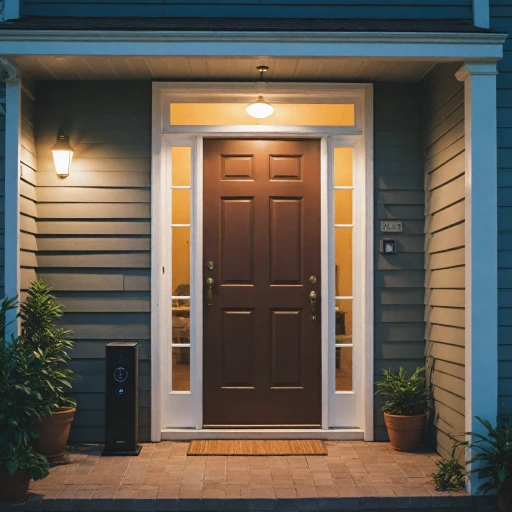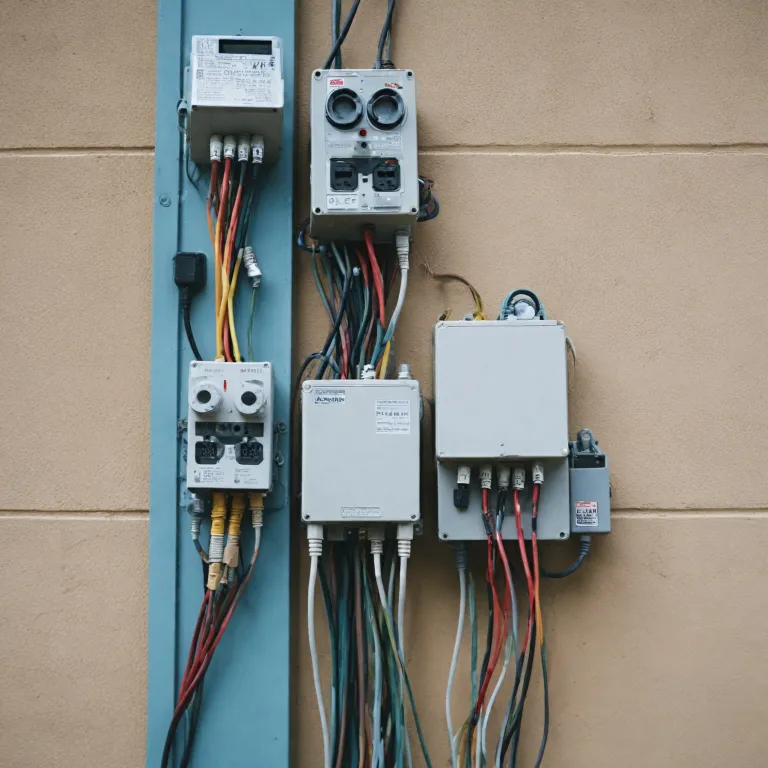Types of Power Supply for Ring Cameras
Exploring Different Power Options
When considering the power supply for Ring cameras, understanding the various options available is crucial for both efficiency and compatibility. With an array of power choices on the market, each catering to specific needs, it is important to know which one aligns best with your security system.
Battery-powered Ring cameras offer ease of installation without the need for cords or cables, making them an excellent choice for areas with limited access to electrical outlets. However, users must monitor battery life and ensure timely replacements or recharges to avoid any security lapses.
Another popular option is the use of power over ethernet (PoE). PoE provides a reliable power supply by transmitting power and data through a single ethernet cable, reducing the clutter of multiple cables and supporting efficient energy consumption. This method is especially favorable for those seeking
a wireless security solution with consistent power supply.
Hardwired power supplies are also common, requiring a direct connection to the building's electrical system. This option ensures a constant power supply, reducing the risk associated with battery depletion or signal loss. Yet, hardwired systems can be more challenging to install, requiring professional assistance for optimal setup.
For more complex camera systems, powered cameras might involve cable connections to a power distribution box. These boxes, often compliant with safety standards, support multiple cameras while simplifying maintenance through a centralized power source.
Selecting the right power type for your security camera involves considering a balance between convenience, reliability, and installation complexity. Each option provides its unique set of advantages, making this decision pivotal for long-term camera power maintenance.
Advantages and Disadvantages of Each Power Type
Weighing the Pros and Cons of Power Supply Types for Security Cameras
When choosing the right power supply for your surveillance camera, understanding the advantages and disadvantages of each type is crucial. Whether you’re shopping for a wireless or wired system, each power type impacts both initial setup and long-term reliability.
AC/DC Power Supplies
- Advantages: Widely accessible and straightforward to use, AC/DC power supplies are known for their consistency and support for an array of camera systems. This type of supply often comes with minimal compatibility issues, making it easier to integrate with existing CCTV setups.
- Disadvantages: Physical cables can lead to clutter, especially in a system with multiple cameras. Additionally, dependency on nearby outlets can limit installation flexibility.
Battery-Powered Solutions
- Advantages: Offering unparalleled portability, battery-powered cameras eliminate the need for cables and wires. They are ideal for monitoring areas without easy access to electricity.
- Disadvantages: Power efficiency is a big concern, as these systems require frequent recharging or battery changes. Inefficiencies can lead to unexpected power failures, compromising security.
Power over Ethernet (PoE)
- Advantages: PoE systems simplify installation by routing both data and power through a single ethernet cable. This centralizes power distribution and reduces the complexity of cable management, a clear indicator of efficiency.
- Disadvantages: They require a PoE switch or distribution box, which can add to costs and complexity. Voltage drop over long runs of cable can also be a consideration.
Understanding Cable Importance
Choosing the proper cabling is essential for maintaining system integrity. Effective cable management can prevent problems associated with voltage drops and enhance the overall efficiency of your security setup.
Installation Considerations for Power Supply
Practical Tips for Installing Power Supply
When setting up your surveillance camera system, ensuring a reliable power supply is crucial for the seamless operation of your security cameras. Proper installation requires attention to detail, especially when dealing with different power types like wired or wireless systems. Below are some key considerations and tips to ensure your power supply is set up efficiently and securely:
- Compatibility with Power Types: Before installation, verify that the power supplies you intend to use are compatible with your specific camera models. Each camera system can have different requirements, such as Power over Ethernet (PoE) or traditional AC/DC power supplies. Understanding the role of NDAA compliance and ensuring compatibility with your chosen equipment is vital.
- Cable Management: Efficient cable routing and management help minimize voltage drop, which can impact the performance of powered cameras. For systems using BNC cables or PoE, ensure that cables are protected and concealed to prevent any damage or tampering. Utilizing structured wiring or a designated cctv power distribution box can enhance the organization and reliability of your setup.
- Power Supply Location: Position your power supply optimally to reduce the distance between it and the cameras. This is particularly important for reducing energy loss in systems with extensive cabling. For wireless cameras, ensure that the power sources, such as battery packs or solar panels, receive adequate support either through a strategic placement or efficient environmental adaptation.
- Security and Weather Protection: Install power sources in secure locations that protect them from potential tampering or theft. If placed outdoors, ensure that all components are weather-resistant to prevent any damage. Weatherproof boxes can safeguard connections and extend the longevity of the components.
- Backup Solutions: Incorporate uninterruptible power supplies (UPS) to maintain system operation during outages. This is crucial for DVRS and other critical components of the camera system to avoid recording interruptions. Investing in a comprehensive backup solution will enhance the overall reliability and security of your system.
These steps are essential for maintaining the efficiency and effectiveness of security camera systems and will prepare you to troubleshoot any challenges that might arise. Appropriately installed power supplies safeguard your investment and reinforce the reliability of your surveillance efforts.
Maintaining Power Supply Efficiency
Best Practices for Sustaining Power
Ensuring the longevity and effectiveness of your security cameras heavily relies on maintaining a consistent power supply. Implementing a few best practices can help keep your surveillance systems functioning optimally.
- Regular Check-ups on Connections: It's crucial to periodically inspect all connections and cables related to power supplies. Look for any signs of wear and tear or damage in the cable, BNC connectors, or any add cart components that could impact power flow. A well-maintained power distribution is key to prevent voltage drop and ensure consistent system operation.
- Utilize Power Distribution Boxes: These boxes are essential when deploying multiple CCTV cameras. A power distribution box helps in organizing the cables and power-related components, ensuring that the system receives adequate voltage and amperage across all cameras. This is particularly important for systems that include powered cameras and PTZ units that require more consistent power supply.
- Consider Power Over Ethernet (PoE) Options: With the advent of more advanced security systems, PoE technology offers a streamlined method of providing power supply. PoE systems transfer power along with data using network cables, minimizing the number of cables and simplifying installation. This can enhance system efficiency and reduce maintenance hassle.
- Scheduled Maintenance Plans: Implement a routine maintenance schedule that checks all security camera systems, not just for power issues but overall functionality. Regular checks and services can help in diagnosing potential issues early, extending the life and efficiency of your surveillance set-up.
- Enhance System Redundancy: Having backup solutions like battery packs or uninterrupted power supplies (UPS) can offer temporary relief during power outages. These backup supplies ensure that your camera systems remain operational, securing critical event footage without interruption.
Implementing these practices will safeguard your investment in CCTV and security camera systems by preventing potential power supply issues and promoting sustained operation.
Troubleshooting Common Power Supply Issues
Troubleshooting and Resolving Power Supply Problems
Identifying and addressing power-related issues with your surveillance camera systems is crucial for maintaining security and functionality. Whether you're dealing with cameras ptz, wireless models, or a comprehensive cctv camera system, understanding common power supply problems can help you keep your security cameras operational.
- No Power to Cameras: If your camera system fails to power on, check the power supplies, ensuring that all connections are secure. Examine the power cable and look into the integrity of the BNC connections if applicable. A multimeter can test voltage at the input.
- Fluctuating Power Levels: Voltage drop can cause irregular behavior in powered cameras. Inspect the power distribution box and ensure that it evenly distributes the required power across all devices. Consider using a power ethernet (PoE) system for more stable power delivery, especially with DVRS and other digital systems.
- Interference and Noise: Wireless cameras may experience interference, which impacts performance. Properly shielded cables and a clean power supply are critical. Ensure your security system is adequately grounded to mitigate noise interference.
- Overheating Issues: Warm environments or poorly ventilated boxes can lead to overheating. Regularly clean and inspect your camera systems, ensuring airflow is unobstructed. Power supplies should be far from heat-generating devices.
- Inconsistent Charging: Wireless and rechargeable camera systems might develop charging issues. Regularly cycle your batteries by allowing them to discharge fully before recharging. If charging requires support, consider replacing the cable or the power adapter with a sku power-compliant component.
When troubleshooting fails, check the manufacturer's warranty or consult customer service for assistance. Security systems are complex, but ensuring robust power distribution is a critical component of operational efficiency. As advances in ndaa compliant technologies emerge, staying informed about new power supplies and solutions will help future-proof your systems.
Future Trends in Surveillance Camera Power Supply
Emerging Innovations in Power Supply for Cameras
As technology continues to evolve, so do power supply solutions for surveillance cameras. Understanding the latest trends can help you make informed decisions about your security system's future needs.
The integration of Power over Ethernet (PoE) is revolutionizing how security cameras are installed and powered. With PoE, both power and data travel through a single Ethernet cable, simplifying the setup process and reducing the need for additional wiring. This not only minimizes voltage drop concerns but also improves the overall efficiency of camera systems.
Meanwhile, wireless power supplies are gaining traction, offering flexibility in camera positioning without the constraints of traditional wiring. They cater to diverse SKU power needs and can add cart value by reducing installation complexity. However, it remains crucial to ensure the wireless systems maintain consistent power delivery and address any potential interference issues.
Another promising trend is the advancement in battery technology, enhancing the viability of completely wireless cameras. These developments support the creation of more autonomous camera systems, although they require regular battery monitoring and management to maintain power supply efficiency.
CCTV camera power distribution is also becoming more sophisticated. Distribution boxes are being designed to accommodate a wider range of camera types, including PTZ cameras, offering greater support for diverse security needs.
Looking ahead, the integration of Artificial Intelligence (AI) in power management systems holds promise for dynamic voltage and power adjustment, optimizing the power distribution for complex setups, such as those involving DVRS and wireless cameras.
Lastly, as industry standards evolve, ensuring compliance with NDAA regulations and environmental guidelines will be key in future power supply solutions, as it promises enhanced security and sustainability.
Keeping pace with these trends and understanding the inherent advantages and potential challenges can significantly enhance your security architecture's effectiveness and reliability. With these insights, you can confidently navigate the array of power supplies and the ever-evolving landscape of CCTV systems.

